Excerpts from Jim Conrad's
Naturalist Newsletter
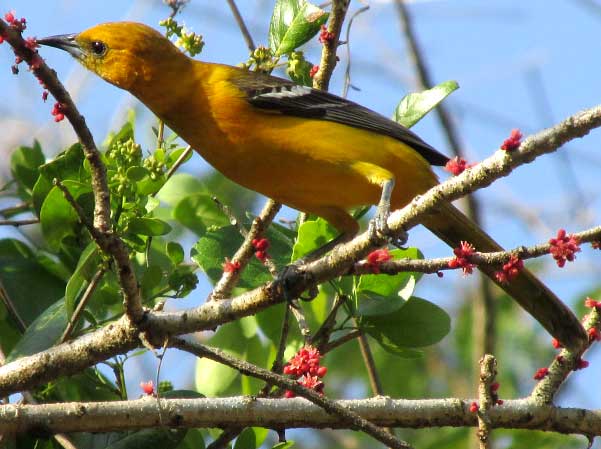
from the April 3, 2016 Newsletter issued from Hacienda Chichen Resort beside Chichén Itzá Ruins, central Yucatán, MÉXICO; limestone bedrock, elevation ~39m (~128ft), ~N20.676°, ~W88.569°
ORIOLES SIPPING FLOWER NECTAR
The Spanish Plum tree, Spondias purpurea, in front of the hut is flowering, its tiny, red blossoms held in pea-sized clusters along its outer branches. We've looked closely at the Spanish Plum's flowers, fruits, leaves and other details.
Here during the heart of the dry season, especially in early mornings and late afternoons, I've noted a new feature of this fine tree, which is that a nice variety of birds visit it to walk along its branches dipping their beaks into one flower after another, clearly sipping nectar. The most commonly seen bird is the Altamira Oriole, an immature individual of which is shown taking a long, deep sip at the top of this page.
Orioles in general are known to have sweet-teeth. The About.Com web page on feeding backyard orioles lists such oriole favorites as grape jelly, orange marmalade, fruits such as oranges and bananas, and suet mixed with bits of fruit, berries or peanut butter. Jelly can be offered in small dishes or in hollowed-out orange rinds, or smeared across the face of a cut-open orange.
That page also reports that orioles will sip sugar-water at hummingbird feeders, if the feeder is big enough to hold them. Moreover, they'll be happy with water containing less sugar than hummingbirds want. Hummingbirds need a water to sugar ratio of 4:1, while orioles will do with 6:1.
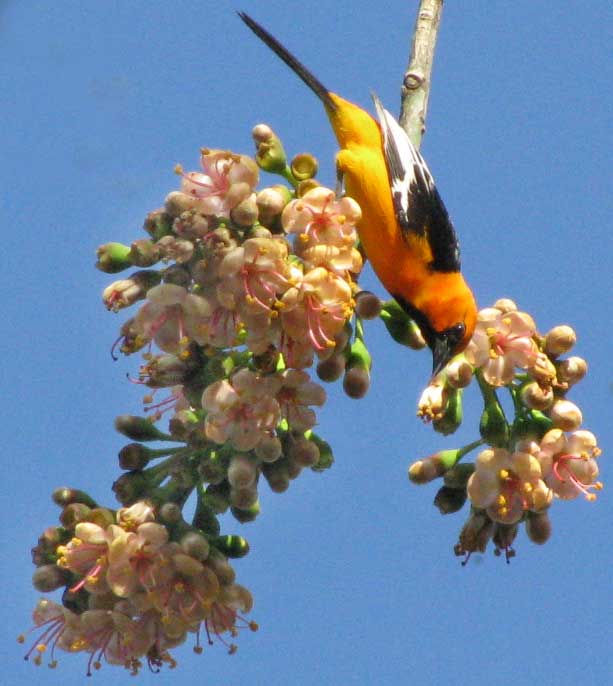
from the January 16, 2011 Newsletter issued from Hacienda Chichen Resort beside Chichén Itzá Ruins; limestone bedrock; elevation ~39m (~128ft), N20.675°, W88.569°; central Yucatán state, MÉXICO
ORIOLES IN THE CEIBA
This week the Ceibas have been flowering much more prolifically than last year, and each morning each Ceiba has constituted nothing less than an animated and gaudy circus.
Beneath one tree you could stand and see dozens of orange or yellow and black orioles at one time -- mostly Altamira but also Hooded, Orchard, Yellow-backed and Baltimore. They, Melodious Blackbirds and Golden-fronted Woodpeckers were after nectar. You could see the woodpeckers' long, black, stiff tongues probing for nectar in the flowers' bottoms. The Squirrel Cuckoos and Turquoise-browed Motmot, however, were after insects, especially what looked like stingless Maya Bees.
A pretty picture of an Altamira Oriole merely hinting of what it was like appears above.
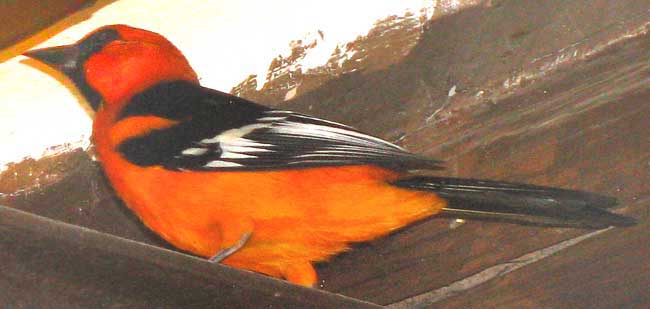
from the November 29, 2009 Newsletter issued from Hacienda Chichen Resort beside Chichén Itzá Ruins, central Yucatán, MÉXICO; limestone bedrock, elevation ~39m (~128ft), ~N20.676°, ~W88.569°
ORIOLE IN THE BAR
The Hacienda offers wireless internet but the signal doesn't reach my place. Therefore each morning I pack up my laptop and head for the bar, which also is the computer room. Tuesday morning when I entered, the guys were standing around looking at the ceiling. An oriole had entered and didn't know how to get out. You can see him on a rafter right beneath the ceiling above.
That's an Altamira Oriole, ICTERUS GULARIS, a permanent resident from the southern tip of Texas through Mexico's eastern and southern lowlands, south to Nicaragua. They're common here and often you hear their bright chiu calls and other songs. This one called a few times while he was trying to escape, the feeling of being upset easy to hear in his voice.
At www.backyardnature.net/yucatan/orioles.htm I list and talk about the northern Yucatan's six oriole species. Because the orioles' female, juvenile and first-year plumages are often similar among the species, in the field it can be hard to impossible to identify certain individuals to species level. Usually adult males are easy to distinguish, though. Still, our Hooded Orioles, also common here, look a lot like Altamiras.
The Hooded is a little smaller, has a decurved upper bill, and the large wing patch where the wing bends -- the upper wingbar -- is white, while you can see that the Altamira's is orange. In the field I find the first two field marks hard to use, so usually it comes down to hoping I have an adult male to look at and, if so, checking to see if the upper wingbar is white or orange.
This is another bird who favors semiopen and disturbed areas, which accounts for it common occurrence.
from the January 22, 2012 Newsletter issued from Hacienda Chichen Resort beside Chichén Itzá Ruins; limestone bedrock; elevation ~39m (~128ft), N20.675°, W88.569°; central Yucatán state, MÉXICO
HUNGRY BIRDS
Last Monday morning, everything seemed hungry, and I'm not sure why. Maybe it was because it was such a perfect, moist, warm, springy morning (despite all the dry-season-falling leaves) that many organisms, including myself, just felt like gorging on everything.
For example, in a leafless, super-prolifically fruiting Cow-Itch tree (Urera baccifera) an Altamira Oriole took his time stuffing himself with BB-size fruits, as shown below:
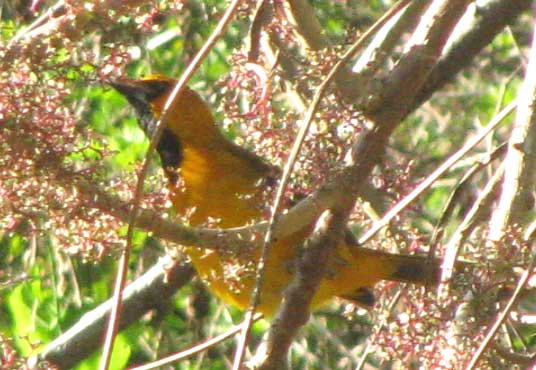
Another Altamira Oriole perched atop the highest bouquet of a flowering African Tulip Tree dipping his beak into pooled water or maybe preying on flower bugs, the blossoms' yellow-orangeness perfectly complementing the oriole's bright plumage, as seen below:
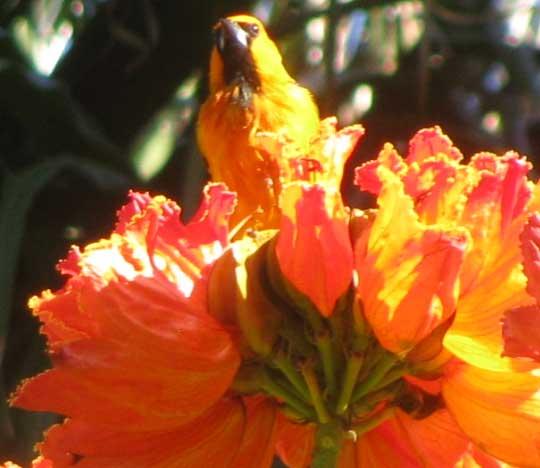
from the June 21, 2015 Newsletter issued from Río Lagartos, on the Yucatan Peninsula's northern coast (~N21.60°, ~W88.16°), Yucatán state, MÉXICO
ORIOLES BUILDING NESTS
Suddenly impressive oriole nests are appearing out in the scrub, such as the one shown below inside the tall fruiting head of a Caribbean Agave:
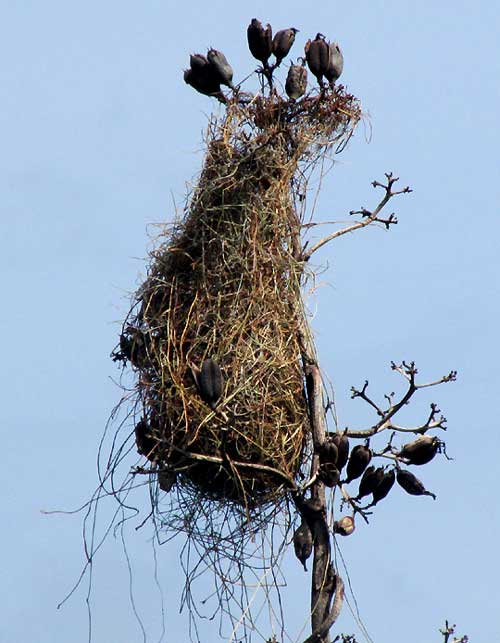
Along the coastal road, also you see lots of nests like the one shown below:
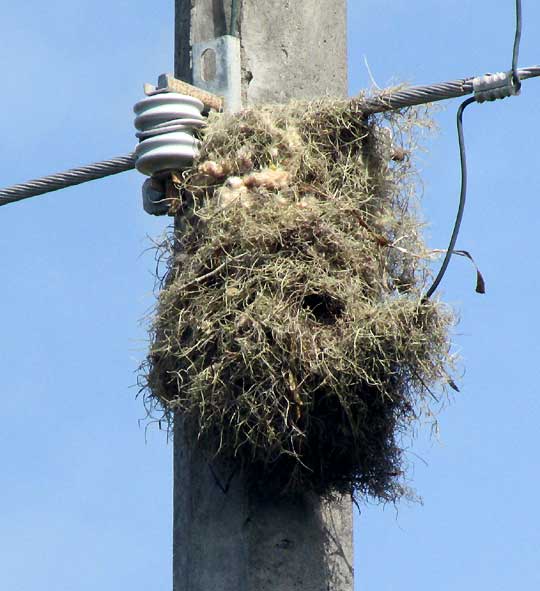
That one, instead of dangling freely as oriole nests normally do, is fairly stably wedged between the pole and the ground wire curving beneath it. In some spots along the road, every light pole for a good distance has its nest perched just like, plus other nests hang freely from wires between poles, blowing in the wind. Oriole nests have their entry holes at their tops. What appears to be an entry hole in this nest may just be a shadowy area, for it seems too small for an oriole to enter.
Seeing how large these nests were, I figured they were being made by Altamira Orioles, our largest oriole species and the one known to construct the largest nests, normally about two feet long (60cm). And that was the case when I came upon a bird working on a nest, shown below:
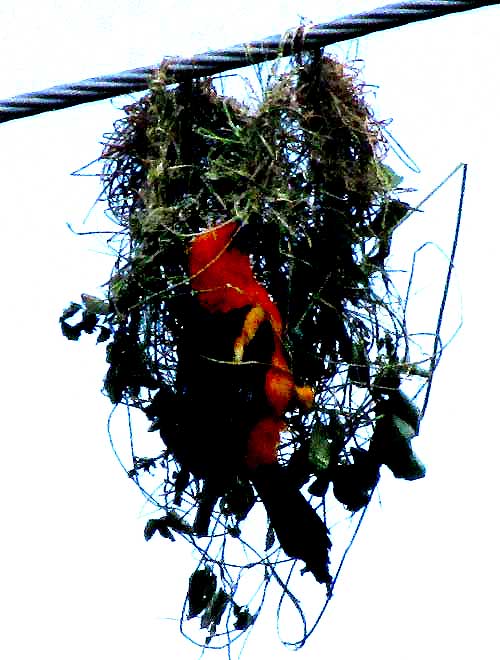
I read that the male follows the female while she collects nest materials, and remains nearby during nest building, incubation, and when she broods the chicks, so apparently our picture shows a female; I saw no male hanging around. In this species, the sexes are similar.
It's amazing to think about the detail of the nest-making information that must be stored in these birds' genes. The AllAboutBirds.Org website describes the Baltimore Oriole's nest-building technique, which is similar to the Altamira's. First the female hangs long fibers over the branch or wire, then pokes and darts her bill in and out of them until she tangles them. "While no knots are deliberately tied, soon the random poking has made knots and tangles, and the female brings more fibers to extend, close, and finally line the nest," the page says. Seeing the neat, tight loops anchoring the above nest to the wire, it's hard to believe that mere random poking created them.
When the above bird would finished adding a fiber, she'd immediately fly into the scrub, be gone three to five minutes, and return with another fiber. She'd rest on the wire, fiber in beak, for maybe fifteen seconds, then go to work. The nest oscillated furiously because of a strong wind that day, and the bird had to contort herself into all kinds of shapes to do her weaving. Try to figure out her leg positions in the picture below:
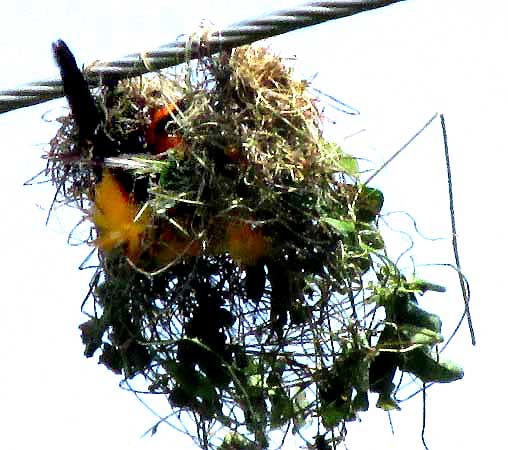
And imagine what strain was felt with the wing way back and the tail way forward as she struggled on the gyrating nest below:
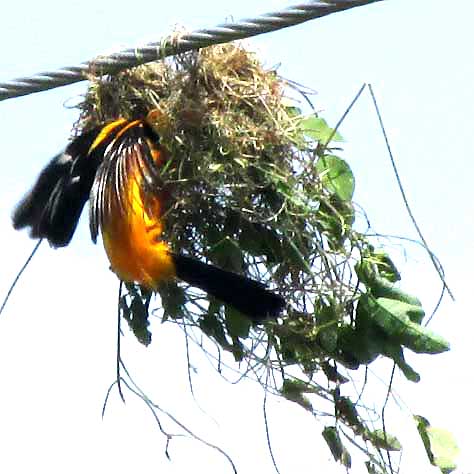
Altamira Orioles are known to take up to 26 days to finish their big nests, much longer than the temperate-zone species. Soon after these pictures were taken I returned to the area to find fewer nests than before. A big rain had come with strong wings, so maybe many fell apart or came loose from their anchoring.
Newsletter entry of May 15, 2019, issued from the forest just west of Tepakán; elev. ~9m (~30 ft), N21.053°, W89.052°; north-central Yucatán state, MÉXICO
STARTING A NEST
Each morning I eat my granola beside an acacia tree in which three bird species are building their nests: Melodious Blackbirds, Social Flycatchers, and Altamira Orioles. The first two species are building inside clumps of Tropical Mistletoe, Psittacanthus mayanus, while the oriole is at the first stage of building its pendulous nest, as shown below:
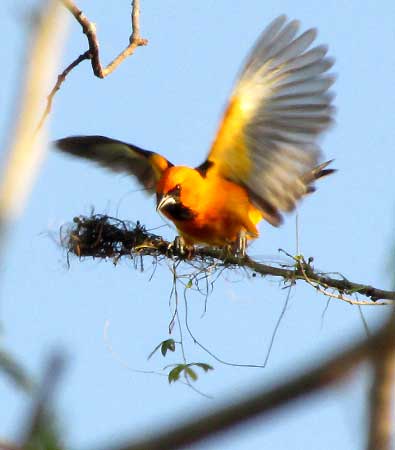
I've read that the Alramira's nest building technique is similar to the Baltimore Orioles, which is described as simply hanging long fibers over a branch or wire, then poking the bill in and out of the fibers until they're tangled. "While no knots are deliberately tied, soon the random poking has made knots and tangles, and the female brings more fibers to extend, close, and finally line the nest," I read.
To that description I can add that sometimes the bird spends fifteen or so seconds tugging or otherwise doing something with her bill other than randomly poking. Sometimes a fiber snaps, or something unexpected like that, and the birds seems to lose her balance and flap her wings, as in the picture. I'm not close enough to provide a detailed description of what she's doing, but it often certainly goes beyond random poking.
Also, four days after the above photo was taken, the nest had achieved what's shown below:
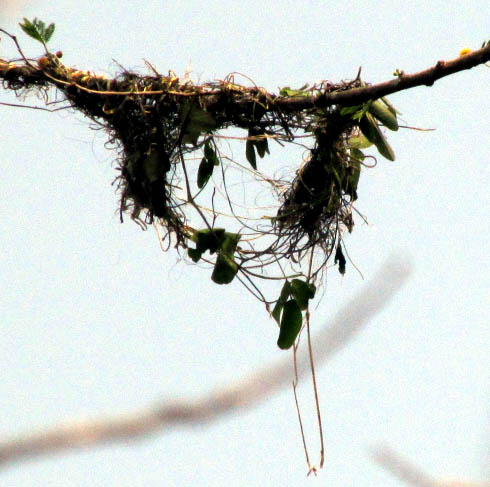
The manner in which the fibers that earlier were dangling free now have been maneuvered into a hanging arch suggests more than random poking. I've also read that as the female builds the nest, the male perches nearby watching. This week while the female tugged at her fibers, a Melodious Blackbird came too close, and the male appeared out of nowhere and chased the intruder away.